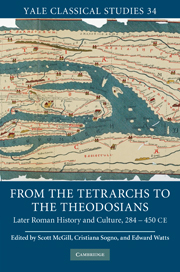Book contents
- Frontmatter
- Contents
- Acknowledgments
- Introduction
- PART I POLITICS, LAW, AND SOCIETY
- PART II BIOGRAPHY AND PANEGYRICS
- 6 Three generations of Christian philosophical biography
- 7 The education of Paulinus of Pella: learning in the late empire
- 8 Another man's miracles: recasting Aelius Donatus in Phocas's Life of Virgil
- 9 Gregory of Nazianzus's Life of Julian revisited (Or. 4 and 5): the art of governance by invective
- PART III FACES OF THEODOSIUS I
- References
- Index
6 - Three generations of Christian philosophical biography
from PART II - BIOGRAPHY AND PANEGYRICS
Published online by Cambridge University Press: 04 August 2010
- Frontmatter
- Contents
- Acknowledgments
- Introduction
- PART I POLITICS, LAW, AND SOCIETY
- PART II BIOGRAPHY AND PANEGYRICS
- 6 Three generations of Christian philosophical biography
- 7 The education of Paulinus of Pella: learning in the late empire
- 8 Another man's miracles: recasting Aelius Donatus in Phocas's Life of Virgil
- 9 Gregory of Nazianzus's Life of Julian revisited (Or. 4 and 5): the art of governance by invective
- PART III FACES OF THEODOSIUS I
- References
- Index
Summary
The famous Symeon, the great wonder of the world, is known by all the subjects of the Roman Empire and has also been heard of by the Persians, the Medes, the Ethiopians; and the rapid spread of his fame as far as the nomadic Scythians has taught his love of labor and his philosophy.
(Theodoret, Religious History, 26.1)The monastic saints, who excite only the contempt and pity of a philosopher, were respected, and almost adored, by the prince and people. Successive crowds of pilgrims from Gaul and India saluted the divine pillar of Simeon; the tribes of Saracens disputed in arms the honour of his benediction, the queens of Arabia and Persia gratefully confessed his supernatural virtue; and the angelic Hermit was consulted by the younger Theodosius in the most important concerns of the church and state.
(Edward Gibbon, Decline and Fall of the Roman Empire, 1.37)Both of these passages refer to the same person, the famous Syrian ascetic Simeon Stylites. The first, the opening sentence of Theodoret's biography of Simeon, marks him as a powerful and famous philosopher whose physical discipline defined his philosophical achievements. The second, Gibbon's description of Simeon and ascetics like him in his Decline and Fall of the Roman Empire, places the saint in a category of men “who excite only the contempt and pity of a philosopher” and whose labors can be dismissed as perverse manifestations of misplaced social and religious priorities.
- Type
- Chapter
- Information
- From the Tetrarchs to the TheodosiansLater Roman History and Culture, 284–450 CE, pp. 117 - 134Publisher: Cambridge University PressPrint publication year: 2010



